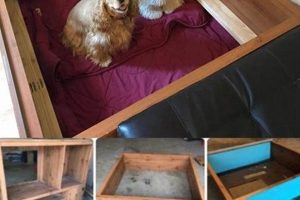A handmade frame or device designed for weaving fabrics or other structured textiles is a cost-effective and customizable alternative to commercially manufactured equipment. Examples include cardboard frames, repurposed picture frames, and constructions assembled from wood or PVC pipes. These provide a platform for interlacing threads to create woven pieces.
The construction and utilization of such devices offer several advantages. Reduced financial outlay makes textile arts more accessible. Building one provides a hands-on learning experience in engineering and design principles. Historically, simple weaving devices have played a significant role in developing weaving techniques and textile production across cultures, predating mechanized looms. These fostered creativity, resourcefulness, and self-sufficiency.
The following sections will delve into specific types of these crafting tools, detailing their construction, practical applications, and potential for artistic expression. Emphasis will be placed on readily available materials and straightforward construction methods, ensuring accessibility for individuals of all skill levels.
Tips for Working With a Self-Made Weaving Frame
Effective utilization of a self-constructed weaving frame requires careful planning and execution. These tips provide guidance for achieving optimal results and maximizing the device’s potential.
Tip 1: Secure Frame Construction. A stable frame is paramount. Ensure all joints are firmly connected and that the frame can withstand the tension of the warp threads without warping or collapsing. Reinforce weak points with additional supports if necessary.
Tip 2: Warp Thread Selection. Choose warp threads based on the desired fabric characteristics. Strong, relatively inelastic threads such as cotton or linen are generally recommended for warp threads, as they will be under significant tension during the weaving process.
Tip 3: Consistent Warp Thread Tension. Maintaining uniform tension on the warp threads is essential for producing a consistent weave. Use a warping board or similar device to ensure equal spacing and tension across the entire width of the frame.
Tip 4: Consider Weft Thread Choices. Weft threads can be chosen for aesthetic and functional properties. Experiment with different textures, colors, and materials to create unique woven designs.
Tip 5: Use a Shed Stick. A shed stick, a flat piece of wood or plastic, facilitates the creation of a shed, which simplifies the insertion of the weft thread. This significantly speeds up the weaving process and reduces the risk of snagging warp threads.
Tip 6: Edge Management. Maintain even edges by consistently wrapping the weft thread around the outermost warp threads. This prevents the fabric from narrowing or becoming uneven.
Tip 7: Consistent Beating. Use a beater or comb to consistently pack the weft threads tightly against each other. This creates a denser, more durable fabric.
Tip 8: Gradual Project Advancement. Avoid weaving too much at once. Advance the woven fabric gradually to maintain control over tension and prevent distortion. Loosen the warp threads slightly as needed, especially when working on larger projects.
Adhering to these guidelines will enhance the weaving experience and improve the quality of the finished product. Careful attention to detail and a methodical approach are key to successfully using a self-made weaving frame.
The following sections will explore specific applications of these frames, demonstrating the versatility and creative potential of this accessible weaving method.
1. Frame Material
The selection of material for constructing a weaving frame fundamentally impacts the frame’s structural integrity, ease of use, and the types of projects it can support. Proper consideration of material properties is essential for a functional and durable device.
- Wood
Wood offers a balance of strength, workability, and aesthetic appeal. Softwoods like pine are easily cut and assembled, making them suitable for beginner projects. Hardwoods such as oak or maple provide superior rigidity and resistance to warping, which are critical for larger or more demanding weaving tasks. The natural texture and finish of wood can also enhance the visual appeal of the frame itself.
- PVC Pipe
Polyvinyl chloride (PVC) pipe presents a lightweight and cost-effective alternative. It is resistant to moisture and can be easily cut and joined using PVC cement. This material is well-suited for frames intended for outdoor use or in humid environments. However, PVC lacks the rigidity of wood and may require additional bracing to prevent bending under warp tension.
- Cardboard
Cardboard provides an accessible and readily available option for constructing simple weaving frames. It is easily cut and shaped, making it ideal for introductory projects and educational purposes. While cardboard lacks durability and is susceptible to moisture damage, it serves as a practical and inexpensive material for exploring basic weaving techniques before committing to more permanent frame materials.
- Metal
Metal, particularly steel or aluminum, offers exceptional strength and stability for crafting looms. Metal frames are best suited for serious weaving projects. Frames made of metal are less subject to the fluctuations of temperature or moisture, which wood frames are commonly impacted by. To use metal in crafting looms, welding equipment is typically needed.
The interplay between material properties and the intended application is central to a successful outcome. A well-chosen material, coupled with sound construction techniques, contributes significantly to the longevity, functionality, and overall weaving experience when creating a self-made weaving frame. Careful evaluation ensures optimal project success.
2. Warp Tension
Warp tension represents a critical element in the functionality of any hand-crafted weaving frame. The consistency and degree of tension applied to the warp threads directly influence the quality, uniformity, and structural integrity of the woven fabric. Insufficient or uneven tension results in loose, distorted weaves, while excessive tension risks frame damage or warp thread breakage. The frames design and materials must accommodate the applied force. For instance, a cardboard frame, unlike one constructed from hardwood, will have a limited tension threshold. A practical example: in crafting a simple tapestry, loose warp tension leads to gaps and misalignment in the design, whereas balanced tension yields a clean, defined image.
Achieving optimal tension requires careful consideration of several factors. The type of warp thread, its elasticity, and the desired fabric density all play a role. Uniform spacing of t
he warp threads, often achieved using a warping board or similar aid, contributes to even tension distribution. Adjustments may be necessary as weaving progresses, especially when working on larger projects. One real-world scenario involves creating a woven scarf; a tightly warped frame produces a dense, warm scarf, whereas a loosely warped frame results in a more open, airy weave.
In summary, warp tension is a fundamental principle governing the success of textile creation using a self-constructed weaving frame. Challenges associated with maintaining consistent tension can be mitigated through careful frame design, appropriate material selection, and diligent weaving techniques. Understanding and managing tension is paramount for achieving desired outcomes and realizing the creative potential of this textile art form. Successfully balancing warp tension directly correlates to the functional longevity of a frame.
3. Weaving Pattern
A weaving pattern dictates the interlacement of warp and weft threads, fundamentally determining the appearance and structure of the resultant fabric. The type of device influences the complexity and range of patterns that can be executed. A simple, self-constructed weaving frame may limit options to basic over-under weaves or variations thereof, while more elaborate designs, or larger frames can accommodate intricate designs. The looms construction directly causes restraints which will determine the kind of pattern you create. The loom’s design, specifically the ease with which sheds can be created and managed, significantly constrains the types of achievable weaving patterns. A rudimentary frame, for example, facilitates plain weave but complicates more complex patterns requiring multiple shed changes. The frame design, in these cases, is a component of the limitations and potential for the weaving pattern. A practical example: crafting a checkerboard pattern on a frame demands precise weft placement and consistent tension, attainable through strategic warp thread manipulation and a robust frame that maintains alignment.
Understanding the interplay between weaving pattern and frame design enables informed decision-making in both frame construction and pattern selection. If one desires to create complex designs, it necessitates either a more sophisticated frame or adapting simpler patterns to the frame’s limitations. Experimentation with different thread types and colors can also compensate for pattern simplicity. Moreover, the frame’s dimensions must correlate with the intended pattern size; a small frame will limit the scope of large-scale patterns, requiring segmented construction or pattern alteration. Applying this knowledge: a crafter intending to produce a striped blanket could choose a straightforward plain weave with alternating colored weft threads, achieving the desired visual effect while adhering to the capabilities of a simple frame. This is a practical example of how the frame influences the pattern you select.
In summary, the weaving pattern stands as an integral determinant of the outcome when using a handcrafted frame. Frame design, warp management, and pattern selection are intrinsically linked, requiring the user to adapt approaches depending on the available tools and desired project outcomes. Understanding these core elements presents the opportunity for resourceful crafting and realization of a varied scope of woven designs using economical weaving techniques. Recognizing this will result in a better approach, and a higher possibility of success. One should consider the patterns possibilities and limitations to yield a better result.
4. Project Size
The dimensions of the intended project exert a considerable influence on the design and construction of a self-made weaving frame. Project size determines material requirements, structural demands, and the overall weaving process.
- Frame Dimensions
The size of the frame directly corresponds to the maximum dimensions of the woven piece. Larger projects, such as blankets or wall hangings, necessitate larger frames to accommodate the required width and length. Frame design must account for the increased tension and weight associated with larger projects, requiring more robust materials and construction methods. For example, a small frame crafted from cardboard is adequate for producing coasters or small decorative items, while a larger blanket would demand a sturdier frame constructed from wood or metal.
- Warp Length and Thread Count
Project size dictates the required length of warp threads and the number of warp threads needed to achieve the desired fabric density. Larger projects require significantly more warp thread, increasing material costs and preparation time. Accurate calculation of warp length is crucial to prevent material shortages during the weaving process. The density of warp threads, measured in ends per inch (EPI), affects the drape and texture of the woven fabric, influencing the overall aesthetic and functional properties of the finished piece. A tapestry frame needs to have the length accounted for, where something simple, like a table mat, will not be as big of an issue to account for.
- Structural Integrity
As project size increases, the structural demands on the weaving frame escalate. Larger frames are subjected to greater warp tension, which can lead to warping, bending, or even breakage if the frame is not adequately reinforced. Corner joints and bracing mechanisms must be designed to withstand the increased stress. Material selection plays a critical role in ensuring frame stability. Hardwoods and metals offer superior strength compared to softwoods or cardboard, making them better suited for supporting large-scale weaving projects. For instance, a blanket is more apt to warp a frame than a bracelet or arm band.
Understanding the connection between project size and loom design is crucial for successful textile creation using a self-made frame. Proper planning, material selection, and construction techniques are essential for accommodating the demands of the intended project, ensuring structural integrity, and achieving the desired aesthetic and functional outcomes. Frame size matters if the loom cannot accommodate for the material.
5. Weft Selection
Weft selection holds substantial influence over the final characteristics of woven fabric produced on self-constructed weaving frames. The choice of weft material dictates factors ranging from texture and drape to durability and visual appearance. The capabilities of the frame itself directly affect the feasibility of different weft options. For instance, a frame constructed from fragile materials may be unable to withstand the friction or weight associated with heavy or highly textured weft yarns. Conversely, a robust frame allows for greater experimentation with varied weft materials, yielding a broader spectrum of textile outcomes. Using a thin weft thread can create gaps in the pattern if the weaver isn’t experienced with the usage of thin thread. Choosing heavy weft materials can cause warp thread breakage. These are situations that must be accounted for.
Practical applications of informed weft selection are numerous. Consider the creation of a woven r
ug: a durable, tightly twisted wool yarn would be an appropriate weft choice to withstand wear and tear, while a delicate silk weft would be unsuitable. In contrast, a lightweight cotton or linen weft would be ideal for creating a breathable summer scarf on a smaller weaving frame. Similarly, the use of novelty yarns with varying textures and colors can add visual interest and dimension to wall hangings or other decorative textiles. In a project aimed at weaving a summer scarf, the same durable weft as a rug would not be useful. The key factor in this case would be the comfort, weight, and breathability of the selected thread.
In summary, weft selection represents a critical decision point in textile creation using a self-made weaving frame. The properties of the weft material must align with the frame’s capabilities and the intended function and aesthetic of the final product. A thorough understanding of the relationship between weft selection and frame characteristics is essential for realizing the full potential of hand-crafted weaving and achieving successful, visually appealing results. This can determine the functionality of the product, or even impact whether the product lasts for years versus breaking on the first use.
6. Edge Finishing
Edge finishing in the context of self-constructed weaving devices refers to the techniques employed to secure and refine the borders of a woven piece. The methods chosen impact the durability, appearance, and overall quality of the final product. The frame affects the means in which edges are constructed. The loom itself becomes a parameter to the process.
- Selvedge Formation
Selvedges are the self-finished edges of a woven fabric, created during the weaving process. On frames without automated shedding mechanisms, maintaining consistent selvedges requires careful manipulation of the weft thread, ensuring it loops around the outermost warp threads at each pass. This prevents unraveling and creates a clean, professional-looking edge. A loosely made frame can inhibit the selvedge’s ability to be pulled taught.
- Fringe Creation
Fringes offer a decorative edge finishing option. They are formed by leaving the warp threads extending beyond the woven area. Securing the fringe, such as through knotting or braiding, is crucial to prevent unraveling. The size of the loom must be adequate to account for the fringe. The frame’s construction impacts how these warp extensions are arranged and managed.
- Binding Techniques
Binding involves securing the edges of the woven fabric with additional thread or yarn. This can be achieved through various methods, including overhand knots, whip stitching, or crochet edging. Binding reinforces the edges, preventing fraying and adding a decorative element. A larger frame, in these cases, is easier to manipulate. The frame, or the space it allows, will determine the means by which binding is used. The means you select for this will influence the outcome.
- Finishing on the Frame
Certain edge finishing techniques can be executed directly on the weaving frame. This involves manipulating the warp and weft threads to create a secure and decorative edge before removing the fabric from the frame. Examples include creating a header or footer by weaving a few rows of tight plain weave at the beginning and end of the project. When removing from a frame, there are techniques you may use to provide a solid finish, even before doing so. Frames with adjustable tension may provide different means to manage the edge to a greater end than those without tensioning.
These facets of edge finishing, when skillfully applied on a hand-crafted weaving device, contribute significantly to the overall quality and visual appeal of the finished textile. Frame affects weave outcome. The various techniques used for edge finishing are closely tied to the characteristics of the weaving frame being employed, and the overall aesthetic and functional goals of the project.
Frequently Asked Questions
This section addresses common inquiries and misconceptions regarding the design, construction, and utilization of weaving frames made from readily available materials.
Question 1: What is the minimum size requirement for crafting a functional weaving frame?
The minimum functional size is dictated by the intended project. Small frames, approximately 6×6 inches, are suitable for coasters or small swatches. Larger projects, such as scarves or small tapestries, necessitate frames measuring at least 12×18 inches. Structural integrity is of greater importance as frame size increases.
Question 2: Which materials offer the most cost-effective balance of durability and ease of construction for a weaving frame?
Wood, particularly softwood lumber like pine, presents a suitable compromise. It is relatively inexpensive, readily available, and easily cut and assembled using basic tools. PVC pipe offers another affordable option, though it may require additional bracing for larger projects due to its flexibility.
Question 3: How does warp thread tension impact the quality of the woven fabric?
Consistent and appropriate warp thread tension is essential for producing uniform and structurally sound fabric. Insufficient tension leads to loose, uneven weaves, while excessive tension risks frame damage or thread breakage. Careful attention to tension management throughout the weaving process is crucial.
Question 4: What are the primary limitations of simple, self-made weaving frames compared to commercially manufactured looms?
Self-constructed frames often lack features such as automated shedding mechanisms and precise tension control, limiting the complexity and speed of weaving. They may also be less durable than professionally manufactured looms, particularly when subjected to heavy use or significant tension. The level of skill required is also significant.
Question 5: Is it possible to create complex weaving patterns on a basic frame, or are patterns limited to plain weave?
While plain weave is the simplest and most readily achievable pattern, variations such as twill and rib weaves can be executed on a basic frame with careful manipulation of the warp threads. More complex patterns may require advanced techniques or modifications to the frame design.
Question 6: What steps can be taken to prevent the edges of woven fabric from unraveling when using a self-made frame?
Securing the edges is critical for preventing unraveling. Techniques include creating selvedges by looping the weft thread around the outermost warp threads, adding fringe and knotting the warp threads, or binding the edges with additional yarn or thread.
In summary, self-constructed weaving frames offer an accessible and economical entry point into textile arts. While certain limitations exist, careful planning, material selection, and attention to technique enable the creation of diverse and functional woven pieces.
The following sections will delve into advanced techniques and creative applications using these crafting tools.
Conclusion
This exploration of the “diy loom” has demonstrated its accessibility as a tool for textile creation. The capacity to construct a functional weaving device from readily available materials empowers individuals to engage in weaving without significant financial investment. The aforementioned discussion of frame materials, warp tension management, weaving
patterns, project size considerations, weft selection, and edge finishing techniques provides a foundation for successful implementation.
Continued exploration and refinement of building practices promise to unlock new creative possibilities within the realm of textile arts. Further investigation into alternative materials, innovative frame designs, and advanced weaving methods will expand the capabilities of such devices, solidifying their relevance in both educational and artistic contexts. The diy loom enables access to weaving practices that might otherwise be unavailable.







